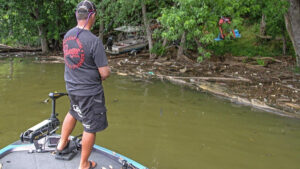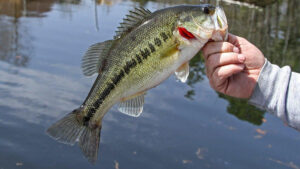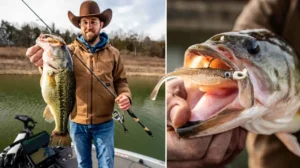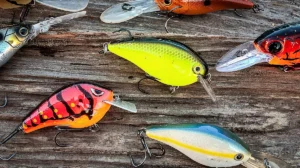If water flows, solid objects dividing or deflecting the flow create bass feeding opportunities. Ditto for anything that encourages a baitfish to tarry or adjust its course.
That’s the logic behind an assortment of features that break up the bank. Some are natural, others manmade; in any case, pay attention to these shoreline interruptions.
On point
From a grassy point with brush; a finger of thick, orange clay; or a rocky protrusion, these pronounced extensions are natural bass magnets.
“Points offer the first break in wind and current,” said Bassmaster Elite Series pro Dennis Tietje. “In lakes or tidal waters, it all works the same way.”
Note that additional structure such as standing cypress, logs/laydowns or isolated boulders enhance the point appeal.
Wood works
Lacking points, logs, laydowns and stumps still do a fine job of breaking up a bank’s continuity. Bassmaster Elite Pro Greg Hackney won’t miss the chance to flip or pitch a Texas-rigged Strike King Rage Tail worm into the thickest parts of the cover and let it slither into the danger zone.
On the initial approach, FLW pro Pete Ponds suggests probing a laydown’s perimeter with topwaters to pick off the ones that are amped up and ready to bite. He’ll move in tighter with Bandit 100 and 200 crankbaits to bump his way across the bigger branches. (A similar approach could be tailored for a cluster of stumps.)
Dock duty
When you think about it, the laydown logic transfers well to these manmade platforms for fishing and boat tethering. The more advanced the design the better, but don’t overlook a skinny, featureless dock – especially one standing all by its lonesome. Shade is shade and when a dock presents the only shoreline break for 100 yards or more, you can bet there’ll be bass lounging beneath.
Work all around and under the dock with a mix of reaction baits and your flipping/pitching presentations, especially the perennial dock sleeper – the shaky head. When the bite is tough, a slender worm standing up all vulnerable like is an easy sell.
Riprap rules
Now, when it comes to profoundly interrupting a natural bank, riprap brings some serious bass habitat with a lot to offer. Diagonal in slope, these piles of rock anchoring marina shorelines, bridge embankments and anything you don’t want washing away extend into the water several yards. Convenience abounds, as riprap provides a staircase for fish to move throughout the water column as conditions dictate.
Moreover, the algae caking the shallower rocks create a baitfish magnet. Where there’s food, there’s bass and, as Elite pro Dean Rojas observes, these rocks are a good bet for primary targets and fallback plans.
“Even if you’ve never been to a lake, concentrate on a riprap bank and you’re going to do pretty good,” Rojas said. “Nothing provides cover like riprap because it’s usually close to deep water and there’s lots of (baitfish and crawfish) there.”
And before you let the seeming homogenous appearance lull you into riprap apathy, note that this bank-breakup definitely has its sweet spots. Elite pro Dean Rojas looks for random brush, windblown logs and debris and any type of riprap point.
With the latter, look for a marina entrance, the corner of a bridge embankment, or even the edge of a break in the riprap. All present ambush spots and prime targets for your crankbaits, spinnerbaits and jerkbaits.
“These are your high percentage spots,” Rojas said. “There’s a change in the shoreline here and anytime you have a transition in a bank, there’s always going to be fish around there,” Rojas said.
In the coastal reaches of Texas and Louisiana, Stephen Johnston expects riprap banks to offer alternating opportunities with redfish and bass mingled in brackish-to-fresh zones. In this scenario, Johnston seeks transitional shorelines where bulkheads meet riprap and riprap meets sand.
“When there’s a change in the bank, there’s typically a change out where you’re fishing,” Johnston said. “It might be a few inches or a couple of feet.”
Noting that riprap in tidal waters will offer bass a bountiful mix of fresh and brackish forage, Johnston said that one of his favorite baits for this deal is a V&M Lightning Blade with a V&M Thunder Shad trailer. If he thinks a slimmer profile will coax indecisive fish, he’ll lose the skirt let the swimbait trailer close the sale.
Less obvious examples
Tietje said the old logging float lanes cut into the swampy reaches off historic waterways like the Red, Atchafalaya, Mermentau, and Calcasieu rivers can be gold mines of overlooked opportunity. Often hard to spot, these narrow passage ways once saw loggers balancing in small boats and to guide their lumber out of the backwaters. Now, these abandoned lanes offer potential big-bass habitat for those sharp enough to spot the opportunities.
“All the old rivers have lanes where (the lumber industry) floated cypress trees out of the swamps,” Tietje said. “This created very good bass spots. They may be only 10-20 feet wide, but they create water flow in and out of the swamps and fish congregate there. It might only be a foot or two difference in depth, but where it enters the river, it’s a break that fish will utilize.”
Creature baits are Tietje’s top choice for probing these logging lanes, but he’ll often start with a spinnerbait or a KVD 1.5 squarebill to check for reaction bites.
Elsewhere, look for:
- Small paved ramps breaking the contour of a backwater pocket, maybe a residential shoreline.
- The landward terminus of an old roadbed. (Such structures are often exposed during the fall drawdown.
- Rafts of wind-driven wood and debris often harbor overlooked fish that are less pressured. With two feet or more of water below, these random conglomerations tend to settle into pockets and shoreline contour changes.
In all of these scenarios, the bottom line principle is this: Anything that breaks up a shoreline provides that fish-attracting “something different” feature. Such spots typically provide some type of solid structure representing shelter and feeding opportunities for bass.
Might be that such diversity also resets our inner focus, tells our brain to shake off the dust and pay closer attention.
















